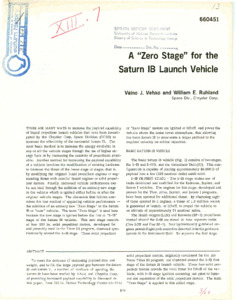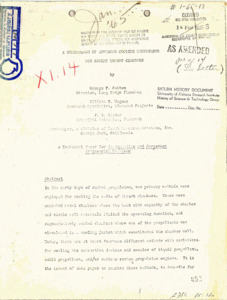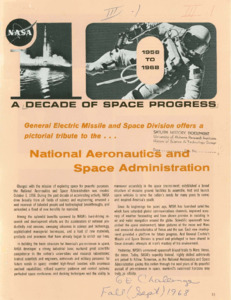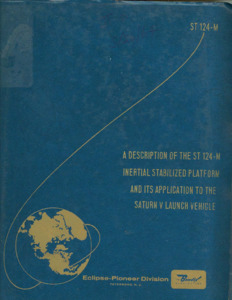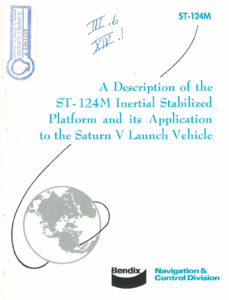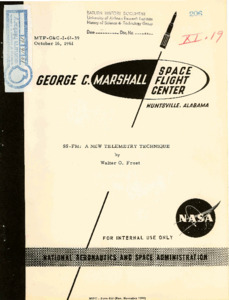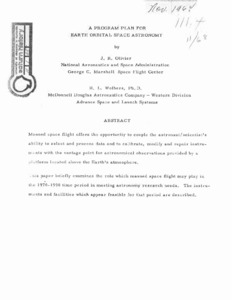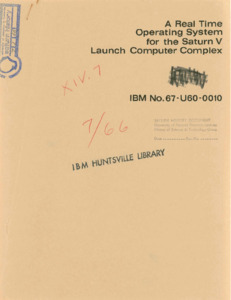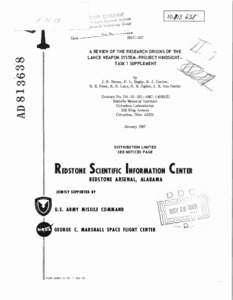
Browse Items (716 total)
Sort by:
-
"A 'Zero Stage' for the Saturn IB Launch Vehicle."
To meet the demands of increasing payload size and weight, and to fill the large payload gap between the Saturn IB and Saturn V, a number of methods of uprating the Saturn IB have been studied by NASA and Chrysler Corp. of providing increased payload capability is discussed in this paper. Four 120 in. United Technology Center UA-1205 solid propellant motors, originally developed for the Air Force Titan III program, are clustered around the S-IB first stage of the Saturn IB launch vehicle. These four solid propellant motors provide the total thrust for liftoff of the vehicle, with S-IB stage ignition occurring just prior to burn-out and separation of the solid propellant motors. The term "Zero Stage" is applied to this added stage. -
"A Comparison of Advanced Cooling Techniques for Rocket Thrust Chambers".
The document is a technical paper for Astronautics and Aerospace Engineering Magazine.The copy has handwritten notes that appear to be for revisions. The abstract states "In the early days of rocket propulsion, two primary methods were employed for cooling the walls of thrust chambers. These were uncooled metal chambers where the heat sink capacity of the chamber and nozzle wall materials limited the operating duration, and regeneratively cooled chambers where one of the propellants was circulated in a cooling jacket which constituted the chamber wall. Today, there are at least fourteen different methods with variations for cooling the combustion devices and nozzles of liquid propellant, solid propellant, and/or nuclear rocket propulsion engines. It is the intent of this paper to examine these methods, to describe for each the useful range of operating conditions, as well as present and likely future applications, to define their limitations and associated problems. Emphasis is primarily placed on liquid rocket engines." -
"A comparison of four control systems proposed for Saturn V launch vehicles."
Presented are the results of a study comparing four proposed control systems for the first stage flight of Saturn V launch vehicles. The primary basis of comparison is the effect on structural loads, using the bending moments at three stations as load indicators. Two of the systems sense only the vehicle attitude and attitude rate, while the other two systems also sense the lateral acceleration. A yaw plane wind response analysis, including rigid body translation, rigid body rotation, four bending modes, five slosh modes, and a non ideal control system, was performed. The winds used in the study were the Marshall synthetic profile and three selected Jimsphere-measured real wind profiles. Load relief obtained from the addition of accelerometer feedback in the control loop amounted to about 10 percent at maximum bending moment station. In view of predicted structural capabilities of the vehicle, this reduction in loads was not considered sufficient to offset the added complexity and the slight reduction in rigid body stability . -
"A decade of space progress, 1958 to 1968: General Electric Missile and Space Division offers a pictorial tribute to the National Aeronautics and Space Administration."
Excerpt from G.E. Challenge, Fall (Sept.) 1968, pages 13 to 25. -
"A Description of the ST 124-M Inertial Stabilized Platform and its Application to the Saturn V Launch Vehicle."
This report is a description of the ST124-M inertial stabilized platform system and its application to the Saturn V launch vehicle. It is a summary report providing the system concept and not a theoretical presentation. Mathematical equations were included only where necessary to describe the equipment; however, the detail derivations supporting these equations were not presented since this was not the theme of the paper. -
"A description of the ST-124M inertial stabilized platform and its application to the Saturn V launch vehicle."
This report is a description of the ST-124M inertial stabilized platform system and its application to the Saturn V launch vehicle. It is a summary report providing the system concept, and not a theoretical presentation. Mathematical equations were included only where necessary to describe the equipment; however, the detailed derivations supporting these equations were not presented since this was not the theme of the paper. -
"A new telemetry technique."
A technique new to telemetry is discussed which promises to alleviate an enigma facing the telemetry engineer : How to adequately transmit the avalanche of vibration and other wideband data desired in the development phase of large missiles and launch vehicles. The data channels are stacked in the frequency spectrum as single sideband subcarriers which frequency modulate the RF carrier. The system design utilizes to advantage the statistical properties of vibration data to achieve maximum data transmission efficiency from the available RF carrier deviation. However, in contrast to proposed statistical predigestion techniques, the data is transmitted in raw form. -
"A Program plan for earth orbital space astronomy."
Manned space flight offers the opportunity to couple the astronaut/scientist's ability to select and process data and to calibrate, modify and repair instruments with the vantage point for astronomical observations provided by a platform located above the Earth's atmosphere. This paper briefly examines the role which manned space flight may play in the 1970-1990 time period in meeting astronomy research needs. The instruments and facilities which appear feasible for that period are described.; Paper presented by J. R. Olivier, National Aeronautics and Space Administration, George C. Marshall Space Flight Center and H. L. Wolbers, Ph.D, McDonnell Douglas Astronautics Company - Western Division, Advance Space and Launch Systems. -
"A real time operating system for the Saturn V launch computer system."
Presentation aimed to encourage a final check on the Saturn V project before its first launch to ensure safety and success. -
"A review of the research origins of the LANCE weapon system -- Project hindsight -- Task 1 supplement."
This report includes a discussion of 57 research and exploratory development events that have been identified as contributing significantly to LANCE. Forty-six of these are research events. Eight of the research events deal with LANCE aerodynamics, four with propulsion, 24 with solid-state components used in the guidance and control system,and 10 with the research origins of the materials and manufacturing processes used in LANCE. In addition, 11 exploratory development events are identified. The principal concern of this study has been the identification of further research origins of LANCE and the 46 documented events are its major product. A further concern and obligation of this study has been to provide HINDSIGHT with some additional data on the research phenomenon including some further observations on the nature and route of research utilization.; FOREWORD: The purpose of this report is to present a survey of fundamental research contributing to the successful development of the LANCE weapon system. Included in this report are discussions of research inputs to a number of LANCE systems and technology areas. The circumstances of these research contributions to LANCE are discussed. The implications of these examples of research utilization are analyzed and some general observations and conclusions on the research payoff phenomena are given. This report was requested by the Army Missile Command as a supplemental contribution to Project HINDSIGHT.; Contract No. DA-01-021-AMC-14693(Z).; Battle Memorial Institute ,Columbus Laboratories.; RSIC-627.; Includes letter from W. Metscher, Lt. Col. to Mr. David L. Christensen dated March 14, 1969.
